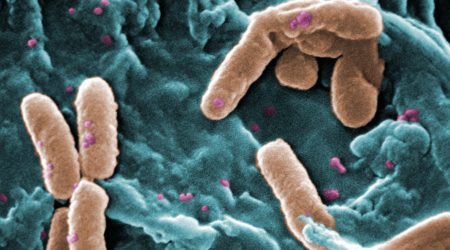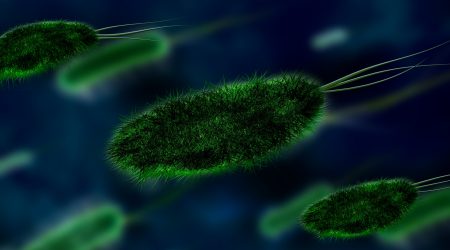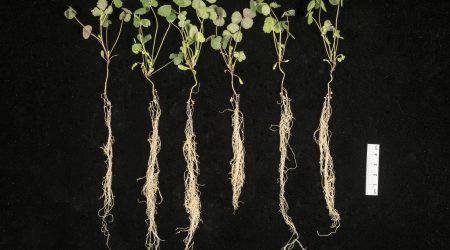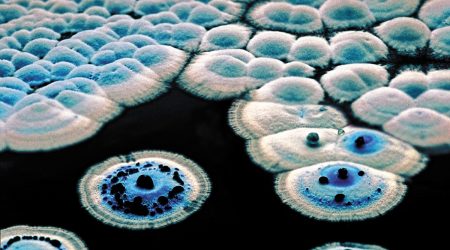Despite more than 50 years of research at the John Innes Centre, we are only now developing the tools we need to study these important bacteria in the wild
Professor Matt Hutchings and his research group are continuing the proud history of research into Streptomyces bacteria at the John Innes Centre, which stretches back to Sir David Hopwood’s arrival in 1967.
Nowadays, the Hutchings group focuses on understanding the roles of Streptomyces species and their specialised metabolites in nature. Matt comments, “We still don’t understand all the roles these bacteria play in the soil, or the function of their specialised metabolites when they are in the wild.”
They collaborate closely in this work with Professor Barrie Wilkinson, a natural products chemist and his group. Early work on the different Streptomyces species involved isolating them from soil and screening them to see if they make useful antibiotics. This approach was very successful in the 1940s and 1950s and resulted in the development of many clinically used antibiotics. At that time, around 55 per cent of the antibiotics used as medicines were derived from these natural products.
Since then, scientists have repeatedly rediscovered the same antibiotics from soil bacteria, and big pharmaceutical companies have devoted fewer and fewer resources to antibiotic discovery.
This is a growing societal problem because the antibiotics that were discovered 70 or even 80 years ago have been too widely used and because of this overuse, many disease-causing bacteria and fungi have become resistant to the drugs that once killed them. As a result, we are experiencing bigger outbreaks of diseases caused by drug-resistant bacteria and fungi, diseases that were once treatable with a simple course of antibiotics. This is called Antimicrobial Resistance, or AMR, and it is a global challenge that causes thousands of lives to be lost each year and places an additional strain on health services around the world.
Matt explains: “AMR means there are young, relatively healthy people who are going into hospital, picking up a bug and then getting very sick and even dying, because of a lack of effective antibiotics.”
There is hope, however: “The exciting advance in the 21st century is that we know from sequencing their DNA that Streptomyces bacteria have the instructions to make many more antibiotics, but they just don’t make them when we grow them in the laboratory.”
To understand how and why they make these potentially miraculous molecules, Matt’s group decided to study their ecology, or how they behave in their natural habitats. Streptomyces species have evolved to live in the soil, not in the lab, and it is thought that these molecules, called specialised metabolites, many of which are antibiotics, must confer some benefit in their natural environment.
To investigate this theory, they have been using a resource that is right under their feet. “We have dug up a lot of barley and wheat plants from the John Innes Centre Field Station at Church Farm to see which bacteria live in the soil and which of these can live on and inside the plant roots,” explains Louisa Perry, a Research Technician in Matt’s group. “It is incredibly useful to have access to Church Farm to investigate this question. We not only use the soil to see which bacteria live there, we also use it to grow plants in the laboratory.”
If you are a bacterium the soil is a very harsh environment to live in. Almost all the nutrients required to survive come from plants. Because of this the Hutchings group decided to study the interaction of Streptomyces bacteria with plants, including bread wheat, which is vital to human survival.
So far, research carried out by Drs Sarah Worsley, Jake Newitt and Sam Prudence, working in Matt’s group, has discovered that Streptomyces bacteria are more abundant on and inside wheat plant roots than they are in soil, and they feed on molecules made by the plants. In return, the bacteria provide plant health-promoting properties, increasing plant growth and protecting the plants against disease.
“There are more than 600 known Streptomyces species. So far, we have found that only three of these species are abundant inside wheat roots and we call these endophytes,” says Matt. Many more Streptomyces species live in the rhizosphere, the soil immediately surrounding plant roots, but it seems that they cannot get inside. Matt and the team are working to understand what is special about the endophytes, how and why they can get inside the plant, and why the plant immune system doesn’t kill them when they get there.
While work continues to answer these questions, other areas of interest are being looked at in the group. For example, Dr Damien Gayrard is trying to understand how Streptomyces bacteria colonise more primitive plants like ferns and liverworts, and Louisa Perry is working on the relationship between these bacteria and barley plants. The hope is that in the future these bacteria could be applied as seed coatings to protect important crops against disease-causing bacteria and fungi in the soil.
A final research focus is to investigate if the plants can control the production of antibiotics by these bacteria. If they can, this could provide natural ecological signals that can be used to activate the production of new antibiotics by the Streptomyces bacteria in the laboratory. This could open a new avenue for the development of novel medicines from Streptomyces species and would be a welcome breakthrough in a world where drug resistant bacteria and fungi are causing more and more diseases to be untreatable with current medicines.
Title image and second image in the field - credit Sam Prudence
Confocal microscopy image of transversal cuts of a wheat plant - credit Damien Gayrard







